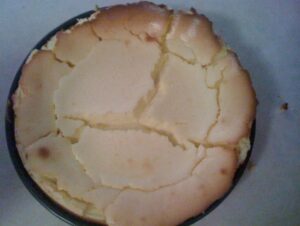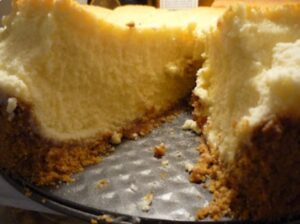Introduction to Cheesecake Baking
Cheesecake stands as a testament to culinary delight, captivating dessert lovers worldwide with its creamy texture and versatile flavors. Originating from ancient Greece, this dessert has evolved through centuries, adopting various forms – from the classic New York style to the light and airy Japanese cheesecake. Its popularity spans continents, making it a staple in both home kitchens and professional bakeries.
However, baking the perfect cheesecake often presents a unique set of challenges. Achieving that flawless, crack-free top and the ideal creamy consistency requires precision and know-how. Common hurdles include preventing surface cracks, ensuring even cooking, and mastering the smooth texture that cheesecake enthusiasts adore. These challenges often intimidate both novice and experienced bakers alike, turning cheesecake baking into a skillful art that demands attention to detail and patience. As we delve into the world of cheesecake, understanding these challenges becomes key to mastering this beloved dessert.if you looking for unique and trendy cheesecake flavors
Common Reasons for Cheesecake Failures
Cheesecake, while a delight to the palate, often falls victim to a few common baking pitfalls. Understanding these can transform your baking experience from frustrating to rewarding.
Cracking tops the list of cheesecake woes. These unsightly fissures typically occur when the cheesecake undergoes sudden temperature changes. Overmixing the batter, which incorporates too much air, also contributes to this problem. This air expands during baking and contracts upon cooling, causing the cheesecake to crack. A gentle mixing technique and a gradual cooling process can help maintain that sought-after smooth top.
Over or Under-Baking significantly affects the final product. An overbaked cheesecake loses its signature creamy texture, turning dry and crumbly. Conversely, under-baking results in a cheesecake that’s too soft and fails to set properly. The key lies in baking the cheesecake just until its edges set but the center remains slightly wobbly. This approach ensures a perfectly cooked cheesecake every time.
Texture Issues such as graininess, lumpiness, or a soupy consistency often stem from improper ingredient handling. Graininess can result from not blending the cream cheese thoroughly. Lumps often appear when ingredients, especially cream cheese, are not at room temperature, leading to uneven mixing. A soupy cheesecake usually indicates under-baking or incorrect ingredient proportions. Ensuring all ingredients are at room temperature and following the recipe precisely can help achieve that ideal creamy, smooth texture that makes cheesecake so irresistible.we offering solutions for when things don’t go as planned
Ingredients and Their Impact
The path to a perfect cheesecake begins with the quality and temperature of its ingredients. Each component plays a pivotal role in the final texture and flavor of the dessert.
Ingredient Quality sets the foundation. High-quality cream cheese delivers a richer taste and smoother texture, essential for a premium cheesecake experience. Similarly, fresh eggs and premium sugar enhance the overall flavor profile. These ingredients, when of superior quality, combine to create a cheesecake that not only tastes better but also has a more appealing texture.
Temperature plays a crucial role, especially for cream cheese and eggs. Room temperature cream cheese blends more smoothly, eliminating the risk of lumps and ensuring a uniform texture. Eggs at room temperature mix more thoroughly with the batter, contributing to a more consistent and stable cheesecake structure.
Eggs, Cream Cheese, and Sugar each contribute uniquely. Eggs act as a binding agent, giving the cheesecake structure and stability. Cream cheese, the star ingredient, provides the characteristic creamy texture and rich flavor. Sugar not only sweetens the dessert but also affects the texture, helping to create a smooth and velvety batter.
Balancing these ingredients correctly and respecting their individual roles is key to achieving the perfect cheesecake – one that’s smooth, creamy, and irresistibly delicious.
Techniques for a Perfect Cheesecake
Mastering a few critical techniques can significantly elevate your cheesecake game, ensuring a perfect bake every time.
Mixing Methods: The way you mix your cheesecake batter can make or break the final result. Overmixing is a common mistake; it whips excess air into the batter, leading to air pockets that expand in the oven and cause cracks as the cheesecake cools. To avoid this, mix the ingredients at a low speed, just enough to blend them smoothly. Start with soft, room-temperature cream cheese to ensure it combines easily with other ingredients without the need for vigorous mixing.
Water Bath Importance: Baking a cheesecake in a water bath (or bain-marie) is a game-changer. The water bath provides gentle, even heat around the cheesecake, preventing the edges from cooking too quickly compared to the center. This method also adds moisture to the oven, reducing the likelihood of cracks and helping the cheesecake cook uniformly to achieve that creamy, dreamy texture.
Oven Temperature and Baking Time: Cheesecakes prefer a low and slow baking process. A moderate oven temperature prevents the top from browning too quickly before the inside is fully cooked. The ideal baking time varies depending on the size and depth of the cheesecake, but a good rule of thumb is to bake until the edges are set, and the center is just slightly wobbly. This residual heat will continue to cook the center as the cheesecake cools, ensuring it’s perfectly set without overbaking.baking techniques in cheesecake preparation.
By honing these techniques, you can consistently produce cheesecakes that are smooth, creamy, and free of cracks, elevating your baking skills to new heights.

Troubleshooting Common Problems
When cheesecake challenges arise, a few strategic solutions can rescue your dessert and restore its glory.
Solving Cracking Issues: Cracks in a cheesecake often stem from overmixing or sudden temperature changes. To prevent this, mix your batter just enough to combine the ingredients smoothly and bake the cheesecake in a water bath. Cooling the cheesecake gradually in the oven with the door slightly ajar helps avoid sudden temperature drops that can cause cracking.
Preventing Sinking: A cheesecake that sinks in the middle usually indicates underbaking or a rapid temperature change. Ensure you bake the cheesecake until the edges are set but the center is slightly wobbly. Let it cool slowly in the oven before transferring it to a countertop, and then to the refrigerator. This gradual process allows the cheesecake to set uniformly without collapsing.
Texture Adjustments: For texture issues like graininess or lumpiness, ensure all ingredients, especially cream cheese and eggs, are at room temperature to blend smoothly. If the cheesecake is too dense, consider reducing the amount of cream cheese or adding a bit more liquid, such as cream or sour cream. For a soupy batter, double-check your measurements, as an excess of liquid ingredients can prevent the cheesecake from setting properly.
Ingredient Proportions and Baking Techniques: Sometimes, tweaking the ingredient ratios can significantly improve the cheesecake’s texture. If the cheesecake is overly dense, slightly increasing the eggs or adding a bit of heavy cream can lighten the texture. Adjusting the baking time and temperature can also help; a lower temperature for a longer period often yields a creamier cheesecake without the risk of overbaking.For a variety of cheesecake recipes and tips
Advanced Baking Tips
Elevating your cheesecake to a professional level involves mastering advanced baking techniques and understanding the nuances of the process.
Effective Use of a Springform Pan: A springform pan is essential for cheesecakes, allowing for easy removal without damaging the delicate dessert. To prevent leaks, wrap the outside of the pan with aluminum foil, especially when using a water bath. Greasing the sides can also help the cheesecake smoothly rise and reduce the risk of cracks.
Achieving a Perfect Crust: The crust sets the stage for a great cheesecake. For a crisp and even base, firmly press the crumb mixture into the bottom of the pan. Pre-baking the crust for a few minutes solidifies its structure, preventing it from becoming soggy once the filling is added. Using high-quality graham crackers or digestive biscuits, and the right amount of melted butter, ensures a flavorful and sturdy foundation.
Cooling and Chilling Techniques: Cooling and chilling are as crucial as the baking itself. Allow the cheesecake to cool gradually in the oven with the door slightly open to avoid thermal shock. Once at room temperature, chill the cheesecake in the refrigerator for several hours, preferably overnight. This slow cooling process enhances the flavors and achieves the perfect creamy, velvety texture.
Decorating and Serving Suggestions
A beautifully decorated cheesecake not only tastes delightful but also makes a stunning visual impact. Here are some creative ideas for toppings and presentations, along with tips for cutting clean slices.
Toppings and Presentation: Elevate your cheesecake with a variety of toppings. Fresh fruits like strawberries, blueberries, or a citrus glaze add a refreshing twist. For a richer flavor, drizzle with salted caramel, chocolate ganache, or a raspberry coulis. A sprinkle of crushed nuts or a dusting of powdered sugar can also enhance the visual appeal. For themed occasions, consider decorative patterns or edible flowers for an elegant touch.
Cutting Techniques: To achieve clean and precise slices, use a long, thin-bladed knife. Dip the knife in hot water and wipe it dry before each cut. This technique ensures the blade smoothly glides through the cheesecake, preventing any filling from sticking to the knife. For mini cheesecakes or individual servings, consider using a cookie cutter for unique shapes.

FAQs on Cheesecake Baking
Q: Why does my cheesecake crack on top?
A: Cracks in cheesecake often occur due to overmixing the batter, which introduces too much air. This air expands during baking and contracts when cooling, leading to cracks. Another common cause is sudden temperature changes. To prevent this, cool the cheesecake gradually in the oven with the door slightly ajar.
Q: How do I know when my cheesecake is perfectly baked?
A: A perfectly baked cheesecake will have set edges with a slightly wobbly center. The center should jiggle just a bit (like Jell-O), indicating it’s cooked but still creamy. Overbaking leads to a dry and crumbly texture, so it’s crucial to time it right.
Q: Can I bake a cheesecake without a water bath?
A: Yes, you can bake a cheesecake without a water bath, but using one helps prevent cracks and ensures even cooking. The water bath method provides gentle heat around the cheesecake, which is key for a smooth, creamy texture.
Q: How long should I cool my cheesecake before refrigerating?
A: Allow your cheesecake to cool at room temperature for about an hour before refrigerating. This gradual cooling helps prevent the cheesecake from sinking or cracking. After it reaches room temperature, refrigerate it for at least four hours, but ideally overnight, for the best texture and flavor.
Q: What’s the best way to get clean slices of cheesecake?
A: For clean slices, use a thin, sharp knife dipped in hot water. Wipe the knife after each cut. This method ensures the cheesecake doesn’t stick to the blade, giving you smooth, even slices.
Q: Can I freeze cheesecake?
A: Yes, cheesecake freezes well. Wrap it tightly in plastic wrap and then in aluminum foil. When ready to serve, thaw it in the refrigerator overnight. This method preserves the texture and flavor of the cheesecake.



